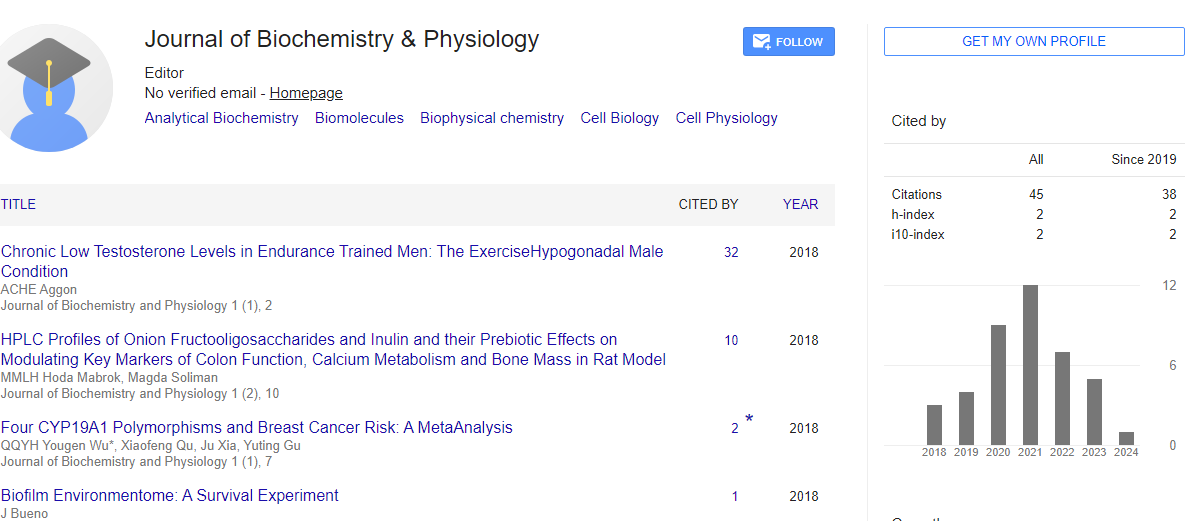Perspective, J Biochem Physiol Vol: 7 Issue: 2
Carbohydrates as Key Players in Vaccine Innovation: From Conjugates to Nanotechnology
Hang Wa*
1Department of Life Sciences, Northwest University, Xi’an, China
*Corresponding Author: Hang Wa,
Department of Life Sciences, Northwest
University, Xi’an, China
E-mail: Waha@ng.cn
Received date: 28 May, 2024, Manuscript No. JBPY-24-139472;
Editor assigned date: 30 May, 2024, PreQC No. JBPY-24-139472 (PQ);
Reviewed date: 13 June, 2024, QC No. JBPY-24-139472;
Revised date: 21 June, 2024, Manuscript No. JBPY-24-139472 (R);
Published date: 28 June, 2024, DOI: 10.4172/jbpy.1000157.
Citation: Wa H (2024) Carbohydrates as Key Players in Vaccine Innovation: From Conjugates to Nanotechnology. J Biochem Physiol 7:2.
Description
Carbohydrates, often associated with energy storage and structural roles in biology, have emerged as important components in the field of vaccine development. Their role extends beyond basic biochemical functions to become key elements in designing effective vaccines against various infectious diseases. The groundbreaking advances in carbohydrate-based vaccines, their mechanisms, and the future prospects for these innovative immunization strategies.
Carbohydrates on the surface of pathogens plays a important role in host-pathogen interactions. These carbohydrate structures, such as polysaccharides, glycoproteins, and glycolipids, are often unique to pathogens and can serve as distinct antigens that bring out specific immune responses. The immune system recognizes these foreign carbohydrates and mounts a defense, making them ideal targets for vaccine development. The specificity of these carbohydrates to pathogens, as opposed to human cells, ensures that the immune response is directed towards the invading organism, minimizing the risk of autoimmunity.
Conjugate vaccines: Enhancing immunogenicity
One of the most notable advancements in carbohydrate-based vaccine development is the creation of conjugate vaccines. Conjugate vaccines improve the immunogenicity of polysaccharide antigens, which are otherwise poorly immunogenic, especially in infants and young children. By chemically linking (conjugating) polysaccharides to protein carriers, these vaccines transform the polysaccharides into T-cell-dependent antigens, thereby eliciting a more powerful and longer-lasting immune response. A landmark in conjugate vaccine technology is the Haemophilus influenzae type b (Hib) vaccine.
This vaccine links the Hib polysaccharide to a protein carrier, such as tetanus or diphtheria toxoid. The conjugation significantly enhances the immune response, making the vaccine effective in infants and young children who would otherwise have a weak response to the plain polysaccharide antigen. The pneumococcal conjugate vaccine targets multiple serotypes of Streptococcus pneumoniae. By conjugating capsular polysaccharides to a protein carrier, the vaccine induces immunity against various pneumococcal strains, offering broad protection and significantly reducing pneumococcal diseases worldwide. Polysaccharides are extracted from the cell walls of pathogens and purified for use in vaccines. This method, while traditional, faces challenges related to the complexity and variability of natural polysaccharides, which can affect vaccine consistency and efficacy. Advances in synthetic chemistry have revolutionized the production of carbohydrate antigens. Synthetic carbohydrates can precisely mimic natural structures, allowing for greater control over the antigen's properties and enhancing immunogenicity and stability.
This approach also reduces variability between vaccine batches, leading to more consistent and reliable vaccines. Glycoconjugate vaccines combine carbohydrates with proteins or peptides to enhance immunogenicity. This strategy is being used to develop vaccines against challenging pathogens like Neisseria meningitidis and Group B Streptococcus. Glycocluster-based vaccines use multiple copies of carbohydrate antigens linked together to form multivalent vaccines. This approach aims to act the natural presentation of carbohydrates on pathogen surfaces, enhancing the immune response. Carbohydratemimetic peptides are designed to resemble carbohydrate antigens structurally. These peptides can induce specific immune responses against carbohydrate antigens, offering a simplified approach to vaccine development without the need for complex carbohydrate synthesis. Nanoparticles are used to deliver carbohydrate antigens more effectively. They enhance the stability and uptake of antigens by immune cells, offering controlled release and targeted delivery, thereby improving the efficacy of carbohydrate-based vaccines.
Despite significant progress, several challenges remain in carbohydrate-based vaccine development. These include the complexity of synthesizing and purifying carbohydrate antigens, the need for effective adjuvants, and the variability in immune responses among different populations. Addressing these challenges requires ongoing research and innovation in carbohydrate chemistry, immunology, and vaccine technology. Future directions in carbohydrate-based vaccines include the development of universal vaccines targeting conserved carbohydrate structures across multiple pathogens and integrating carbohydrate-based antigens into nextgeneration vaccine platforms, such as mRNA vaccines. These advances hold the potential to broaden the applicability of carbohydrate-based vaccines and improve global health outcomes.
Conclusion
Carbohydrates are transforming vaccine development, providing unique advantages in designing effective and safe vaccines. From conjugate vaccines that enhance the immunogenicity of polysaccharide antigens to innovative approaches like glycoclusters and nanoparticle-based delivery systems, carbohydrates are redefining the landscape of vaccinology. As research continues to advance, the potential for carbohydrate-based vaccines to address emerging infectious diseases and improve public health is immense. The exploration of carbohydrate structures and their applications in vaccine development promises to yield new and transformative solutions in the fight against infectious diseases.
 Spanish
Spanish  Chinese
Chinese  Russian
Russian  German
German  French
French  Japanese
Japanese  Portuguese
Portuguese  Hindi
Hindi 